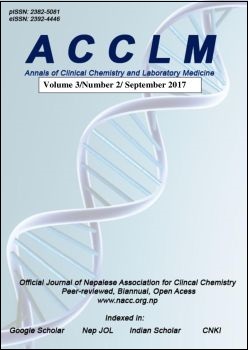Pattern of Antibody Titer Against Salmonella Enterica in Apparently Healthy Individuals
DOI:
https://doi.org/10.3126/acclm.v3i2.20740Keywords:
Widal test, S. typhi, Enteric feverAbstract
Background: Enteric fever is a serious health problem in developing countries including Nepal. Widal test is the routinely used for diagnosis of enteric fever. This study aimed to determine the baseline antibody titers for Salmonella typhi and paratyphi A, B in healthy individuals of Western Region of Nepal.
Methods: A total 150 blood samples were collected from the healthy individuals and pattern of antibody titer was measured using standard quantitative tube method.
Results: Among 150 blood samples, 103 had shown significant antibody titers (≥ 1:20). The significant proportion (10.7%) of the individuals had anti-O titer ≥ 1:80. Similarly, 86 had anti-H titers of ≥ 1:20 to S. enteric serotype typhi, 23 had a titer of ≥1:80 and 4 had a titer of ≥1:160 respectively. We found 10% and 1.3% for paratyphi A and B, anti-H titers of ≥ 1:20respectively
Conclusion: This study concludes that, there should be need to change in the cutoff levels for antibody titer against S. typhi to > 1:80 for both anti-O and anti-H titers for Western Development Region of Nepal.
Downloads
Downloads
Published
How to Cite
Issue
Section
License
Authors who publish with this journal agree to the following terms:
- The author transfers copyright to the Nepalese Association for Clinical Chemistry.
- The journal publishes the work under a Creative Commons Attribution License that allows others to share the work with an acknowledgement of the work's authorship and initial publication in this journal and under the same share-alike license used here.
- Authors are able to enter into separate, additional contractual arrangements for the non-exclusive distribution of the journal's published version of the work (e.g., post it to an institutional repository or publish it in a book), with an acknowledgement of its initial publication in this journal.
- Authors are permitted and encouraged to post their work online (e.g., in institutional repositories or on their website) prior to and during the submission process, as it can lead to productive exchanges, as well as earlier and greater citation of published work (See The Effect of Open Access).




